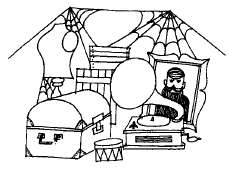![]()

![]()

There can be few of us who do not feel a thrill of excitement at the encounter of a house which has an attic. Sadly for most of us, the discovery of an attic can only be found in fiction, or a film. This small room has always been a place of mystery and of romance. The bride, for instance, who, on playing a teasing game of hide-and-seek, gets locked away in a large oak chest in the attic, or the school-girl, who supposedly became a prisoner of two elderly ladies and was locked up in their attic, or the young boy, who hid what he believed to be magic spells and a few stems of Bella Donna, in the drawer of a wash-stand underneath the attic window.
Besides all this, there is always a treasure of some sort, be it an old masterpiece picture, a cardboard box of rare china, or the jewellery box which, when the lid is sprung, reveals pearls and diamond articles, whilst the pretty ballerina pirouettes gracefully on her enchanting music box. Just a few years ago, this mystery theme was pictured at the commencement of "The Snowman" Video, when David Bowie was shown discovering his old Snowman Scarf in an old chest in an attic. The Brontë Sisters, too, were not above using the haunting atmosphere of an attic in their stories and it is perfectly safe to assume that they must have spent many wet and rainy afternoons in the attic of their Father's Vicarage in the bleak countryside around Howarth in Yorkshire.
The attic, in fact, was a small unwanted space, either in or near the roof, often placed in a gable. Sometimes the only light was a window set in the roof itself, usually of just 4 panes of glass. The door invariably had a small brass handle, and was usually panelled. They were not used as maid's bedrooms, but were designed simply as a Store Room, in which the Rocking Horse, Doll's House, old Deck Chairs and Port-Manteau's, or suit-cases as we would call them today, were kept. The rustling noises in the corridor outside the room, and the creaking floorboards over the worn and shabby carpet, the owls hooting in the woods nearby, plus the scampering and scratching noises in the wainscoting, were all authentic sounds belonging to the genuine attic.
Today, of course, hardly anything ever remotely approximating it, can be found in any dwelling house, at least, not built since the last war. The Church Belfry is perhaps the closest, which nearly all have the required conditions of the old attics, and have in common the small lower room with their miscellany of stored objects. Indeed, some large cathedrals can be quite daunting, with a definite eerie aura to their large Belfries, sometimes only approached through a walkway of old roof rafters containing somewhat ghostly hordes of old and broken or unwanted statuary.
Some garden sheds, placed as they often are amid long grass, with perhaps a creeper to brush the face upon entering the door, do have the same appeal that the old attics had, and in fact any hardly-used small building, be it situated on a beach, in a wood or in a fairly inaccessible site in a garden, can serve to give an unfamiliar uncanny feeling.
Could it be fitting to leave the last word with Agatha Christie, who always found the basements of houses more intriguing than the attics, with the main suspects in her stories, treading their sinister way carefully and quietly up the stairs from the gloomy basements, with the very suspicious-looking glass of milk on its silver tray?
written by Rosemary Goulding
![]() Return to the September 1998 Features page
Return to the September 1998 Features page
![]() return to Home page and main index
return to Home page and main index
page last updated 27 AUGUST 1998